Using Multispectral Drone Imagery for Spatially Explicit Modeling of Wave Attenuation through a Salt Marsh Meadow
Abstract
:1. Introduction
2. Materials and Methods
2.1. Study Site
2.2. Significant Wave Height Measurement (Hm0) as the Model Response
2.3. Multispectral Drone Imagery Acquisition and Processing
2.4. Modeling the Contribution of the Salt Marsh to Wave Attenuation
3. Results
4. Discussion
5. Conclusions
Author Contributions
Funding
Conflicts of Interest
References
- Wayne, C.J. The effects of sea and marsh grass on wave energy. Coast. Res. Notes 1976, 14, 6–8. [Google Scholar]
- Knutson, T.R.; McBride, J.L.; Chan, J.; Emanuel, K.; Holland, G.; Landsea, C.; Held, I.; Kossin, J.P.; Srivastava, A.K.; Sugi, M. Tropical cyclones and climate change. Nat. Geosci. 2010, 3, 157–163. [Google Scholar] [CrossRef] [Green Version]
- Moller, I.; Spencer, T.; French, J.R.; Leggett, D.J.; Dixon, M. Wave transformation over salt marshes: A field and numerical modeling study from North Norfolk, England. Estuar. Coast. Shelf Sci. 1999, 49, 411–426. [Google Scholar] [CrossRef]
- Morgan, P.A.; Burdick, D.M.; Short, F.T. The functions and values of fringing salt marshes in Northern New England, USA. Estuaries Coasts 2009, 32, 483–495. [Google Scholar] [CrossRef]
- Yang, S.L.; Shi, B.W.; Bouma, T.J.; Ysebaert, T. Wave attenuation at a salt marsh margin: A case study of an exposed coast on the Yangtze Estuary. Estuaries Coasts 2012, 35, 169–182. [Google Scholar] [CrossRef]
- Temmerman, S.; Meire, P.; Bouma, T.J.; Herman, P.M.J.; Ysebaert, T.; De Vriend, H.J. Ecosystem-based coastal defence in the face of global change. Nature 2013, 504, 79–83. [Google Scholar] [CrossRef] [PubMed]
- Moller, I.; Kudella, M.; Rupprecht, F.; Spencer, T.; Paul, M.; van Wesenbeeck, B.K.; Wolters, G.; Jensen, K.; Bouma, T.J.; Miranda-Lange, M.; et al. Wave attenuation over coastal salt marshes under storm surge conditions. Nat. Geosci. 2014, 7, 727–731. [Google Scholar] [CrossRef] [Green Version]
- Collin, A.; Lambert, N.; Etienne, S. Satellite-based salt-marsh elevation, vegetation height, and species composition mapping using the superspectral WorldView-3 imagery. Int. J. Remote Sens. 2018, 39, 5619–5637. [Google Scholar] [CrossRef]
- Mury, A.; Collin, A.; Etienne, S. Wave attenuation service of salt marshes and shelly cheniers: A spatio-temporal study in Mont-Saint-Michel Bay, France. In Proceedings of the EGU General Assembly Conference, Vienna, Austria, 8–13 April 2018. [Google Scholar]
- Mury, A.; Collin, A.; James, D.; Pastol, Y.; Etienne, S. Spatially-explicit modeling of the salt marsh wave attenuation using pressure measurements, UAV imagery and LiDAR data. In Proceedings of the EGU General Assembly Conference, Vienna, Austria, 7–12 April 2019. [Google Scholar]
- Mury, A.; Collin, A.; Jeanson, M.; Etienne, S. Wave attenuation service by intertidal coastal ecogeosystems in the Bay of Mont-Saint-Michel, France: Review and meta-analysis. In Estuaries and Coastal Zones in Times of Global Change: Proceeding of ICEC-2018; Nguyen, K.D., Guillou, S., Gourbesville, P., Thiébot, J., Eds.; Springer: Berlin, Germany, 2020. [Google Scholar]
- Lorenzen, B.; Jensen, A. Reflectance of blue, green, red and near infrared radiation from wetland vegetation used in a model discriminating live and dead above ground biomass. New Phytol. 1988, 108, 345–355. [Google Scholar] [CrossRef]
- Elvidge, C.D. Visible and near infrared reflectance characteristics of dry plant material. Int. J. Remote Sens. 1989, 11, 1775–1795. [Google Scholar] [CrossRef]
- Peñuelas, J.; Filella, I. Visible and near infrared reflectance techniques for diagnosing plant physiological status. Trends Plant Sci. 1998, 3, 151–156. [Google Scholar] [CrossRef]
- Collin, A.; Dubois, S.; James, D.; Houet, T. Improving Intertidal Reef Mapping Using UAV Surface, Red Edge, and Near-Infrared Data. Drones 2019, 3, 67. [Google Scholar] [CrossRef] [Green Version]
- Mury, A.; Collin, A.; James, D. Morpho–Sedimentary Monitoring in a Coastal Area, from 1D to 2.5 D, Using Airborne Drone Imagery. Drones 2019, 3, 62. [Google Scholar] [CrossRef] [Green Version]
- James, D.; Collin, A.; Mury, A.; Gloria, H.; Le Poulain, N. Étude spatio-temporelle de la géomorphologie et de l’écologie d’un système dunaire par drone aérien. In Proceedings of the 3ème Colloque Merigéo, Nantes, France, 24–26 November 2020. [Google Scholar]
- Alvarez-Vanhard, E.G.; Houet, T.; Mony, C.; Lecoq, L.; Corpetti, T. Can UAVs fill the gap between in situ surveys and satellites for habitat mapping? Remote Sens. Environ. 2020, 243, 12. [Google Scholar] [CrossRef]
- Archer, A.W. World’s highest tides: Hypertidal coastal systems in North America, South America and Europe. Sediment. Geol. 2013, 1–25, 284–285. [Google Scholar] [CrossRef]
- Détriché, S.; Susperregui, A.S.; Feunteun, E.; Lefeuvre, J.C.; Jigorel, A. Interannual (1999–2005) morphodynamic evolution of macro-tidal salt marshes in Mont-Saint-Michel Bay (France). Cont. Shelf Res. 2011, 31, 611–630. [Google Scholar] [CrossRef]
- Radureau, A.; Lechapt, J.P.; Valery, L. Cartographie de la Végétation et des Gîtes Larvaires Potentiels d’Ochlerotatus des Marais Salés de la Baie du Mont-Saint-Michel; Université de Rennes: Rennes, France, 2011; Volume 1, p. 4. [Google Scholar]
- Fawcett, D.; Panigada, C.; Tagliabue, G.; Boschetti, M.; Celesti, M.; Evdokimov, A.; Biriukova, K.; Colombo, R.; Miglietta, F.; Rascher, U.; et al. Multi-scale evaluation of drone-based multispectral surface reflectance and vegetation indices in operational conditions. Remote Sens. 2020, 12, 514. [Google Scholar] [CrossRef] [Green Version]
- Carter, G.A.; Knapp, A.K. Leaf optical properties in higher plants: Linking spectral characteristics to stress and chlorophyll concentration. Am. J. Bot. 2001, 88, 677–684. [Google Scholar] [CrossRef] [PubMed] [Green Version]
- Horler, D.N.H.; Dockray, M.; Barber, J. The red edge of plant leaf reflectance. Int. J. Remote Sens. 1983, 4, 273–288. [Google Scholar] [CrossRef]
- Cooper, N.J. Wave dissipation across Intertidal surfaces in the wash tidal inlet, Eastern England. J. Coast. Res. 2005, 21, 28–40. [Google Scholar] [CrossRef]
- Bork, E.W.; Su, J.G. Integrating LIDAR data and multispectral imagery for enhanced classification of rangeland vegetation: A meta analysis. Remote Sens. Environ. 2007, 111, 11–24. [Google Scholar] [CrossRef]
- Bertoldi, W.; Gurnell, A.M.; Drake, N.A. The topographic signature of vegetation development along a braided river: Results of a combined analysis of airborne lidar, color air photographs, and ground measurements. Water Resour. Res. 2011, 47, 13. [Google Scholar] [CrossRef]

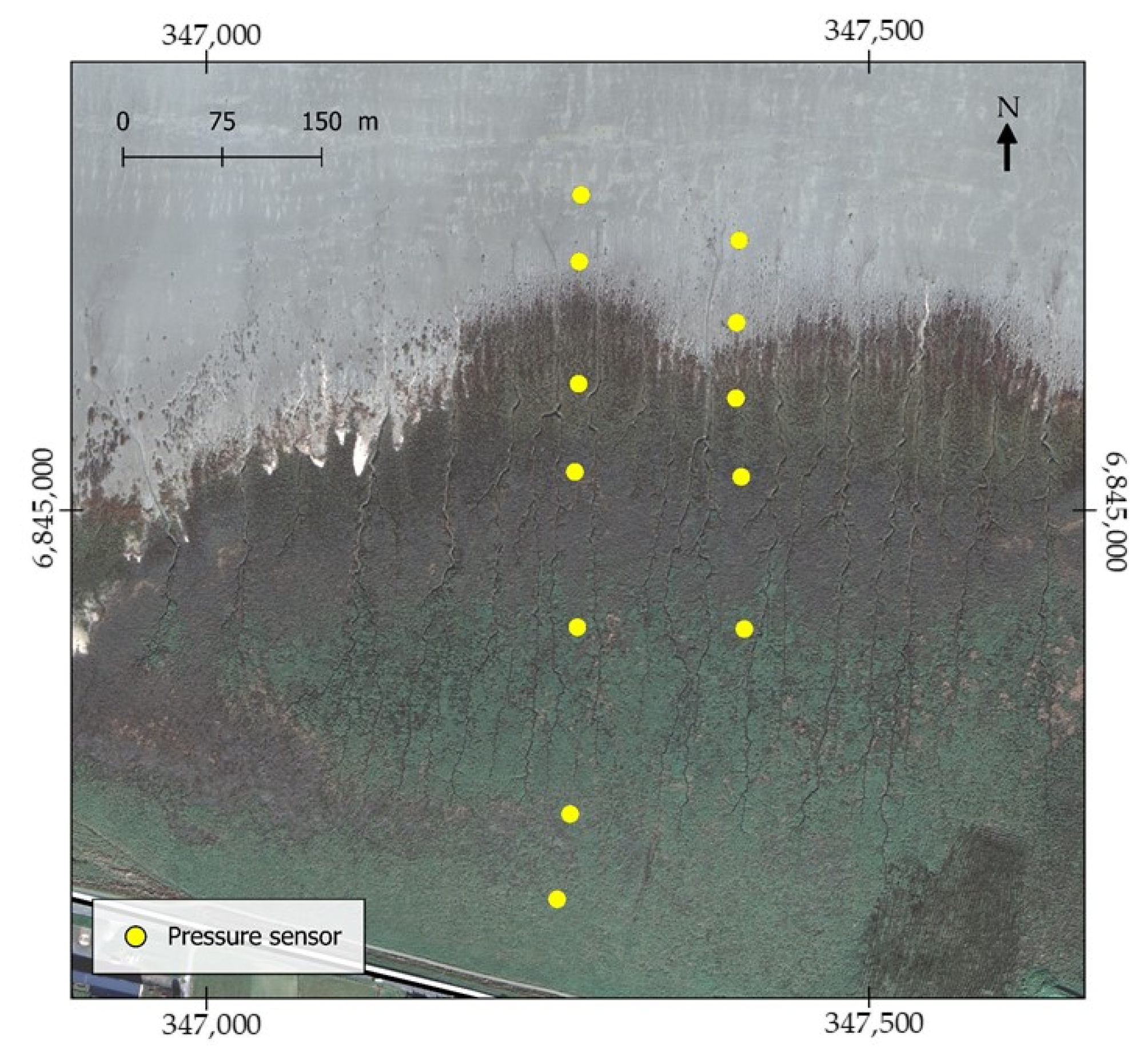
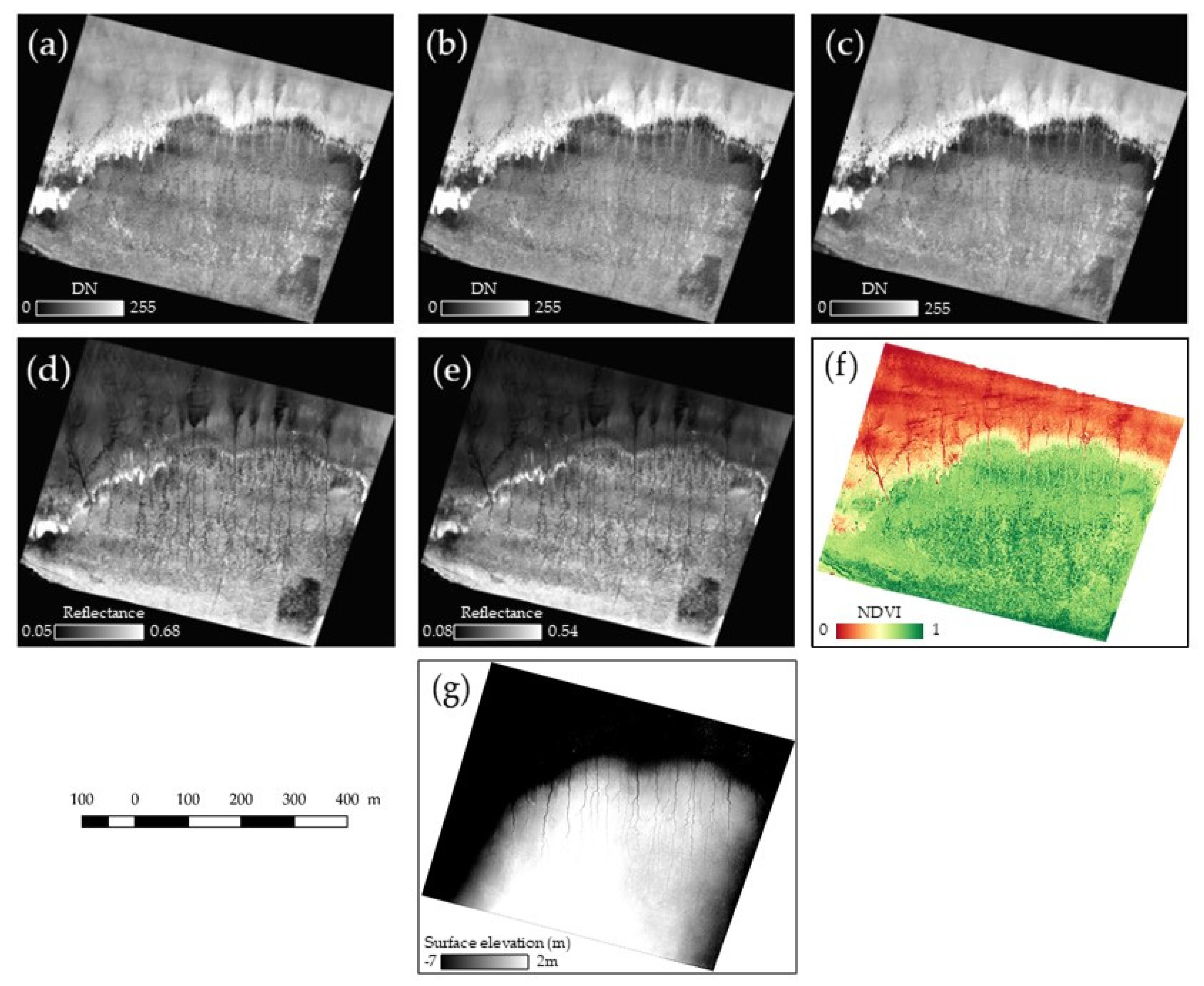

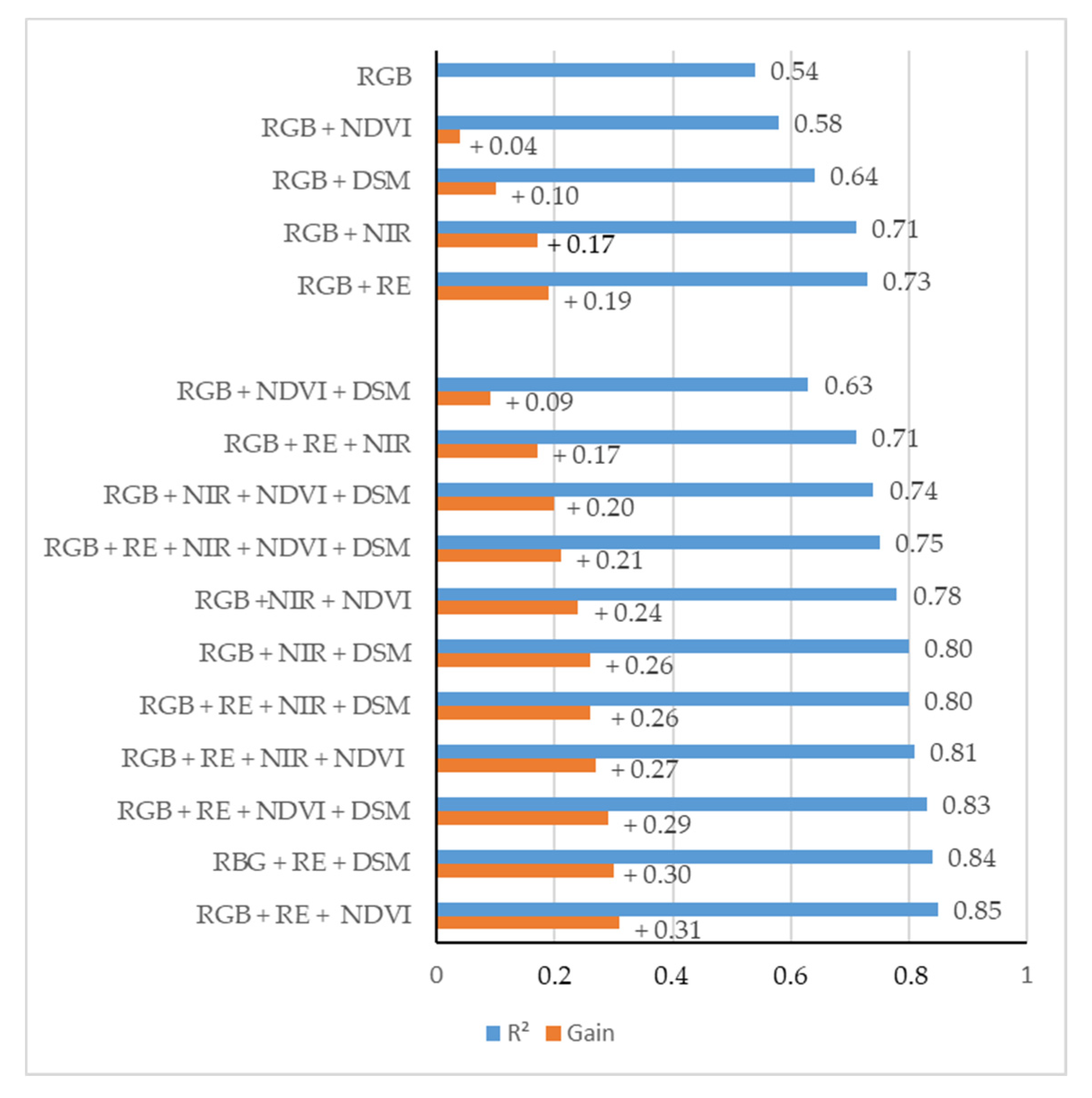

| Pioneer vegetation | Spartina townsendii |  |
| Sueda maritima | 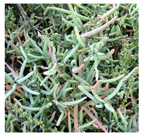 | |
| Salicornia europea | 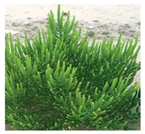 | |
| Short lawn | Puccinellia maritima | 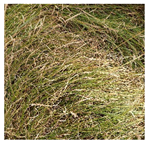 |
| Halimione portulacoides |  | |
| Aster tripolium |  | |
| Semi-woody formation | Halimione portulacoides |  |
| Dense meadow | Festuca rubra | 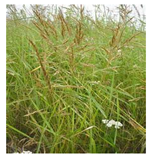 |
| UAS platform | Sensefly eBee+® |
| MultiSensor device | Parrot Sequoia® |
| No. of pixels (RGB sensor) | 5472 × 3648 pixels |
| No. of pixels (Green, Red, Red Edge and Near Infrared sensors) | 1280 × 960 pixels |
| Lens | F/2.3 |
| Flight control software | eMotion 3.5 |
| Flight planning software | eMotion 3.5 |
| Front overlap ratio | 90% |
| Side overlap ratio | 65% |
| Altitude | 150 m |
| Gimbal pitch angle | –90° |
| Shutter interval | 2.6 s |
| Flying time | 25 mn |
| Simple linear regressions | Red; Green; Blue; Red Edge; Near Infrared; Normalize Difference Vegetation Index; Digital Surface Model | |
| Multiple linear regressions | Predictors from visible spectrum | RGB |
| Visible + IR | RGB + RE RGB + NIR RGB + RE + NIR RGB + NDVI RGB + RE + NDVI RGB + NIR + NDVI RGB + RE + NIR + NDVI | |
| Visible + DSM | RGB + DSM | |
| Visible + IR + DSM | RGB + RE + DSM RGB + NIR + DSM RGB + RE + NIR + DSM RGB + NDVI + DSM RGB + RE + NDVI + DSM RGB + NIR + NDVI + DSM RGB + RE + NIR + NDVI + DSM | |
| Predictors | R2 | RMSE | ||
|---|---|---|---|---|
| Simple linear regressions | R | 0.33 | 0.42 | |
| G | 0.51 | 0.36 | ||
| B | 0.50 | 0.36 | ||
| RE | 0.24 | 0.45 | ||
| NIR | 0.32 | 0.42 | ||
| NDVI | 0.41 | 0.39 | ||
| DSM | 0.29 | 0.43 | ||
| Multiple linear regressions | Predictors from visible spectrum | RGB | 0.54 | 0.35 |
| Visible + IR | RGB + RE | 0.73 | 0.26 | |
| RGB + NIR | 0.71 | 0.27 | ||
| RGB + RE + NIR | 0.71 | 0.28 | ||
| RGB + NDVI | 0.58 | 0.33 | ||
| RGB + RE + NDVI | 0.85 | 0.20 | ||
| RGB + NIR + NDVI | 0.78 | 0.24 | ||
| RGB + RE + NIR + NDVI | 0.81 | 0.22 | ||
| Visible + DSM | RGB + DSM | 0.64 | 0.30 | |
| Visible + IR + DSM | RGB + RE + DSM | 0.84 | 0.20 | |
| RGB + NIR + DSM | 0.80 | 0.23 | ||
| RGB + RE + NIR + DSM | 0.80 | 0.23 | ||
| RGB + NDVI + DSM | 0.63 | 0.31 | ||
| RGB + RE + NDVI + DSM | 0.83 | 0.21 | ||
| RGB + NIR + NDVI + DSM | 0.74 | 0.26 | ||
| RGB + RE + NIR + NDVI + DSM | 0.75 | 0.26 | ||
© 2020 by the authors. Licensee MDPI, Basel, Switzerland. This article is an open access article distributed under the terms and conditions of the Creative Commons Attribution (CC BY) license (http://creativecommons.org/licenses/by/4.0/).
Share and Cite
Mury, A.; Collin, A.; Houet, T.; Alvarez-Vanhard, E.; James, D. Using Multispectral Drone Imagery for Spatially Explicit Modeling of Wave Attenuation through a Salt Marsh Meadow. Drones 2020, 4, 25. https://doi.org/10.3390/drones4020025
Mury A, Collin A, Houet T, Alvarez-Vanhard E, James D. Using Multispectral Drone Imagery for Spatially Explicit Modeling of Wave Attenuation through a Salt Marsh Meadow. Drones. 2020; 4(2):25. https://doi.org/10.3390/drones4020025
Chicago/Turabian StyleMury, Antoine, Antoine Collin, Thomas Houet, Emilien Alvarez-Vanhard, and Dorothée James. 2020. "Using Multispectral Drone Imagery for Spatially Explicit Modeling of Wave Attenuation through a Salt Marsh Meadow" Drones 4, no. 2: 25. https://doi.org/10.3390/drones4020025






